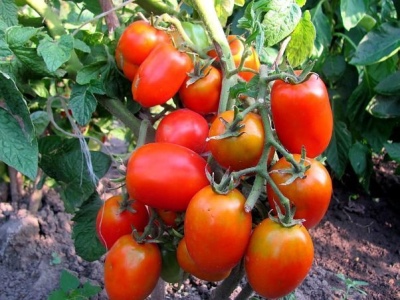
- Authors: Gubko V.N., Zalivakina V.F., Chernovolova O.A., Orlova E.A., Dmitrienko A.E., Gubko V.N., SibNIIRS
- Appeared when crossing: by the method of sexual hybridization of samples from the collection of VIR No. 6710 - Canada and No. K-928 - Hungary with subsequent selection
- Year of approval: 2008
- Category: grade
- Growth type: determinant
- Appointment: fresh consumption, for pickling and canning, for whole-fruit canning
- Ripening period: mid-season
- Ripening time, days: 101
- Growing conditions: for open ground
- Marketable fruit yield,%: 78
Tomato Aquarelle gives fruits of universal purpose, large enough and pleasant to the taste. The plant does not require any special care.
Breeding history
Bred the variety in SibNIIRS. Several employees were involved in the work. The method of sexual hybridization was used to create the Aquarelle variety. To create it, Canada and Hungary took samples. Subsequently, a selection was made. The use of this variety was allowed only in 2008.
Description of the variety
The described variety is determinant. It is only suitable for outdoor planting.
The bushes can reach a height of 45 cm. They are compact in shape, with a strong, stable stem.
The foliage is dark green. Inflorescences are formed simple, the first appears only after 4 leaves. The articulation can be seen on the stalk.
The main qualities of the fruit
Fruits of the Aquarelle variety can be preserved completely, used for the production of juices, and eaten fresh. From each bush, the percentage of marketable fruits is 78%.
In a mature state, the fruits are red, in an unripe state they have streaks of green and red. Tomatoes grow small, weighing only 55 grams. The shape of the tomatoes is elliptical. 8-9 tomatoes can grow on one brush; in total, 7 to 8 brushes are formed on the stem.
After harvesting, the fruits can lie in the warehouse for up to 1.5 months, but provided that the temperature is + 12 ° C. When ripe, the fruits of this variety do not crack, which is an indisputable advantage.
Taste characteristics
Inside, under the skin, there is a dense, sweet pulp.
Ripening and fruiting
Aquarelle is a mid-season variety, the fruits of which, after sowing the seeds, can be harvested in 101 days.
Yield
The plant is high-yielding, Aquarelle gives up to 196 kg / ha.
The timing of planting seedlings and planting in the ground
You need to start planting seeds for seedlings already in March-April. Plants are planted in the ground in June. Landing during the period when the spring frosts end is considered a prerequisite. It is desirable that by this time at least 6 leaves and one flower brush have formed on the bush.

Growing tomato seedlings is an extremely important process, because it largely depends on whether the gardener will be able to harvest at all. All aspects must be taken into account, from seedbed preparation to planting in the ground.
Landing scheme
Planting Watercolors should be done according to the scheme 30x50 cm.

Growing and care
Due to the fact that the bushes are formed small and compact, there is no need for pinching and tying, but this does not mean that other care should be excluded.
Aquarelle tomatoes require regular watering, keeping the soil moist, but not wet. Watering should be abundant, but not on the foliage, but on the ground near the stem. In the southern regions, where high temperatures prevail in summer, you need to mulch the soil. This approach allows you to retain moisture in the soil. Use straw or old compost as mulch.
We must not forget about feeding, because without them the plants will not feel healthy, and the fruits will not reach the required size.
Watercolors are watered with diluted fish emulsion or kelp meal every 3-4 weeks. Add aged compost and spread it around the plants in the middle of the season.
Bloom rot can be the result of uneven watering or lack of calcium in the soil. Crushed eggshells added to the soil every two weeks can provide the required calcium levels. Compost tea gives a lot of nitrogen.
Seedlings of Aquarelle must be given a balanced fertilizer once a month, while the planting material is still in the greenhouse. It is worth using a diluted 3-3-3 fish emulsion or a similar nitrogen-phosphorus-potassium formula.
When the Aquarelle tomatoes are ready to go into the open ground, they dig a hole as deep as a seedling. A layer of rotted compost or well-rotted manure is placed on the bottom, a handful of bone meal and 1 tablespoon of special salt, which contains magnesium and sulfur, are added. These components are of great benefit to the plant's root system.
A layer of soil is poured on top of the fertilizers so that the delicate roots of Aquarelle do not touch the top dressing.
Two weeks after planting, the tomato bushes are watered with compost tea or diluted fish emulsion.




A plant needs different micronutrients at each stage of growth. All fertilizers can be divided into two groups: mineral and organic. Folk remedies are often used: iodine, yeast, bird droppings, eggshells.
It is important to observe the rate and period of feeding. This also applies to folk remedies and organic fertilizers.
Disease and pest resistance
Variety Aquarelle is resistant to top rot of fruits and relatively resistant to tobacco mosaic and septoria.
After planting Watercolors in open ground, it is worth carrying out the first treatment with copper sulfate in two weeks. After a few days, neem oil is applied, which perfectly protects against most pests. An infusion of garlic is considered a good remedy.
If signs of fungal diseases appear, you should immediately use copper or sulfur-based fungicides.


Resistant to adverse weather conditions
Watercolor copes well with cold, but poorly resistant to drought and high temperatures.
Growing regions
It is possible to cultivate a culture in the middle zone of our country and in the south.

























































































